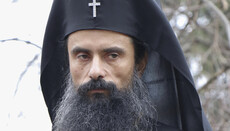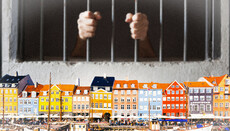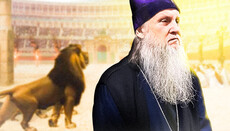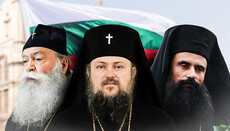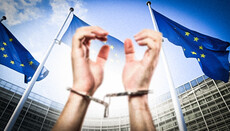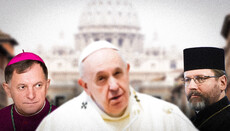Lavra is a cultural hub, relics are "objects": what fate awaits the shrine
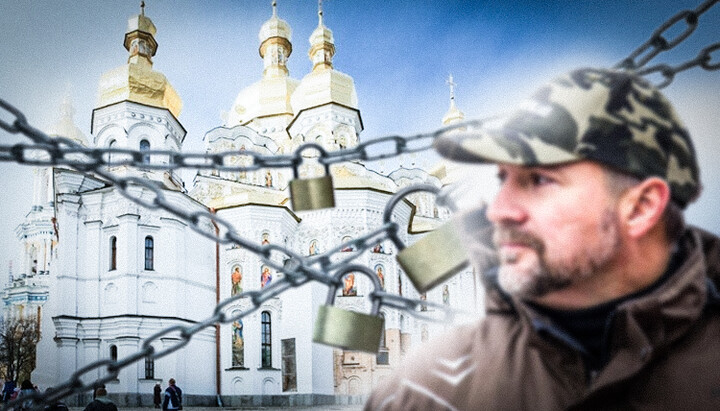
The new head of the "Kyiv-Pechersk Lavra" Reserve gave a program interview. What fate awaits our shrine and will the policies of Soviet power not return to Ukraine?
The new head of the "Kyiv-Pechersk Lavra" Reserve gave a program interview. What fate awaits our shrine and will the policies of Soviet power not return to Ukraine?
On April 29th, it’s a month since the prayer standing of UOC believers under the Kyiv-Pechersk Lavra started. People who restored and rebuilt the shrine 30 years ago cannot believe that today the state, as it did during the USSR, intends to take it away, that the temples will again be closed, and that some exhibitions, expositions, etc. will be organized there. The new head of the Kyiv-Pechersk Lavra Reserve, Maxym Ostapenko, gave a program interview for Radio Liberty, in which he reveals the government's plans for one of the main shrines of the Orthodox world.
"To return the Lavra to the Ukrainian pantheon".
Ostapenko begins his interview by saying that the Kyiv-Pechersk Lavra has always been "an important point of Ukrainian culture and spirituality," but now, he says, it “has found itself at a crossroads".
"We need to change the fundamental situation with the Lavra," says the new director of the Reserve. "And my main message now in these changes, in these circumstances, is to return Ukrainian nature to the Lavra. To return the Lavra to a truly Ukrainian pantheon. Because it can honestly be said that both the last decade and the previous century, especially the 19th century, positioned and associated the Lavra with imperial, Moscow tradition. The Lavra is a unique object of Ukrainian history, Ukrainian heritage, and Ukrainian culture. And we need to take steps now to return everything Ukrainian that is related to the Lavra."
In Ostapenko's opinion, everything Russian should be expelled from the Lavra, and Ukrainian elements should be brought back in. Specifically, "to return the Lavra to a truly Ukrainian pantheon". To achieve this goal, the UOC should be expelled from there.
For anyone even remotely familiar with Ukrainian history, a number of questions immediately arise: what is Ukrainian spirituality and culture, from which historical period it begins its countdown, how it differs or relates to Russian (Kievan-Rus) spirituality and culture, and which territories it extends to, and so on.
Without a preliminary answer to these questions, without a clear definition of the concepts we are working with, it is impossible to have a normal discussion. Moreover, without all of this, we will simply slide into juggling slogans: "Russian world," "Ukrainianism," "imperial narratives," etc. And under slogans, unlike concepts, everyone understands their own thing.
The very first mention of the "Russian world" that has reached us is a quote from the monument of Old Russian literature "Word on the renovation of the Tithes Church": "Not only in Rome but also everywhere: in Chersonesus and in the Russian world". The passage refers to the life and deeds of Saint Clement of Rome, whose revered head rests in the Far Caves of the Lavra. It turns out that Saint Clement (1st century) is associated with the "Russian world".
Also associated with the "Russian world" are saints such as Mercury, Bishop of Smolensk, Niphont, Bishop of Novgorod, Simon, Bishop of Vladimir, Dionysius, Archbishop of Suzdal, St Elijah of Murom and other saints. If the "Russian world" is to be removed from the Lavra, then they should be removed as well, shouldn't they? Or should we define the terms?
For example, what is the concept of "Ukrainian nature"? Do Sts Antony, Theodosius, and other wonder-workers of the Kyiv-Pechersk Lavra (11th-12th centuries) belong to this nature or not?
Recall that the very first mention of the term "Ukraine" appears only in 1187 in the Kievan Chronicle of the Hypatian Codex. In the account of the death of Prince Vladimir Glebovich of Pereyaslavl, it says: "Oukraine mourned him a lot." And in the Constitution of Pylyp Orlyk (1710), the population of our country is never called Ukrainian, only "Little Russian people", and the country itself is called both Ukraine and Little Russia (whoever does not believe can visit the website of the Verkhovna Rada). What are the criteria for separating Russian (Kievan-Russian) from Ukrainian?
But while the concept of nationality can somehow overlap with Christianity, the term "pantheon" is clearly pagan. This was the name of a famous architectural monument of ancient Rome (118-128 AD) – the Pantheon, which means "Temple of all gods" in translation. In a figurative sense, a pantheon is a group of pagan deities belonging to one’s religion or mythology.
What pantheon is M. Ostapenko planning to return the Kyiv-Pechersk Lavra to, if the Lavra is one of the greatest Christian shrines, and the pantheon is a collection of pagan deities?
Holy relics – "objects" and "exhibits"?
If the term "pantheon" comes from paganism, then the terms "items" and "exhibits," which refer to holy relics, come from the recent communist past. Although Ukraine has declared decommunization, current officials still use such terms.
On March 12, 2023, the Minister of Culture, O. Tkachenko, referred to the Kyiv Caves holy relics as "exhibits" on the “1+1” TV channel: "I would like to emphasize that besides immovable property, there are also museum exhibits – more than 800 items, including relics of the saints, which were handed over for use by the monks."
M. Ostapenko calls them "objects": "This is really a matter of state importance because we cannot allow the same relics to simply become items that will lie somewhere in storage."
In fact, holy relics are the remains of people who least of all wished for their bodies to become objects that the state hands over to monks or takes back. According to the teachings of the Church, man is made up of spirit, soul, and body. And the Holy Spirit, the Third Person of the Most Holy Trinity, who indwells a person, makes the entire person a partaker of Divine Energies. That is, the spirit, soul, and body of a person become partakers of God, united with the Holy Spirit, which is preserved even after the soul departs from the body. This is why holy relics work wonders and healings, aiding those who venerate them with faith and love and ask for their help and intercession. Relics cannot be used for trade, reception and transfer, exhibition, and so on. All of this borders on sacrilege. This is what the Soviet authorities did when they turned relics into exhibits in atheism museums. Do the current Ukrainian authorities want to do the same? Apparently so.
Lavra is a "modern cultural centre"
In the USSR, temples were closed and destroyed, and in modern Europe, temples are often repurposed (although they are also destroyed). Probably, the Kyiv-Pechersk Lavra will face similar repurposing.
Just a few weeks after the UOC was expelled from the Upper Lavra, a rock concert was held at Sts Antonius and Theodosius Refectory Church. And in late March 2023, Minister of Culture O. Tkachenko stated: "The Lavra is a gem where visitors should come. The state should develop a plan for the premises so that they can be used for exhibitions, rich displays and thematic meetings so that the Lavra really comes to life."
The new head of the Kyiv-Pechersk Reserve continues to develop this theme: "The Lavra should become a modern cultural centre, where museum objects are already located, where there are excursion programs, where there is a modern information policy on attractions. And this should be shown in the most modern way."
In other words, one of the most important shrines of Orthodoxy, where prayer has been heard for almost a thousand years, is perceived as a certain cultural hub. Of course, this centre should be patriotic. The text of Radio Liberty says: "The new head of the Lavra hopes that his experience in managing the Zaporizhzhia Reserve 'Khortytsia' will help turn the Lavra into a 'maximally patriotic object'".
It cannot be said that M. Ostapenko completely denies the religious significance of the Lavra, but it looks very peculiar. Quote: "The spiritual component of the Lavra should remain. How to make sure that only the people who really support Ukraine, who pray for our soldiers, who help those affected by Russian aggression, remain there? This is the question of this dialogue, which is now actually taking place."
In other words, Ostapenko, like Tkachenko, suggests that only people from the "right" confession should be in the Lavra. And this confession is not the UOC. And this is despite the fact that it was the UOC monastic community, which they are now trying to expel from the Lavra, that helped "those affected by Russian aggression" the most. Neither the Reserve nor the OCU will provide even a tenth of the assistance to the Armed Forces and the victims of the war that the UOC provided.
But that's not the main point. The term "spiritual component" is used in the context of war and patriotism, while the monastery was founded by St. Anthony not for anything else but for the salvation of souls, pleasing God, and the monastic feats of its inhabitants. But for some reason, this is not mentioned.
Another quote from M. Ostapenko's interview: "We need to make the Lavra more modern, and there are technologies that allow us to create virtual collections, to reveal it. That is, the Lavra, in addition to its spiritual component, should become a modern museum, a tourist magnet that will be interesting not only to the over 60s but also to young people."
Yes, in Europe, the oldest monasteries often turn into similar "tourist magnets". Typically, this happens because there are simply no monks there anymore, there are no people who would continue the monastic traditions. Or there are so few of them that they simply cannot maintain the monastery on their own. But in the Kyiv-Pechersk Lavra, everything is different. There is a monastic community, with over 200 monks, there are statutory services and means not only for its maintenance but also for its repair and beautification. And now this monastic community needs to be expelled and "virtual collections" to be demonstrated in the Lavra?
"Rejuvenate the Lavra"
Radio Liberty says that "the new head has ideas for creating modern spaces that will attract children to study the archaeological heritage of the Lavra and launch new tourist routes aimed at young people”.
The ideas of prayer, soul salvation, and attainment of the Holy Spirit are timeless, eternal and always up-to-date. Orthodoxy and monasticism, as the highest image of spiritual life, do not need rejuvenation. Why does M. Ostapenko have ideas on "creating modern spaces" and "launching tourist routes, aimed at young people"?
Like the Bolsheviks, the current authorities of Ukraine are not interested in the Lavra as a monastery, as a place of prayer, as a staircase that ascends from earth to heaven. Only as an object of cultural heritage, and in the context of patriotism and the current war. A quote: "The Lavra must be renewed and rejuvenated to some extent because it is very important now at this stage, especially when we are at war, to educate children, educate Ukrainian patriots on real masterpieces of our heritage, our culture. And this is the task of such objects as the National Reserve and the Kyiv-Pechersk Lavra.”
The Church is not against patriotism. But Orthodoxy is a civilization code of Ukrainian people. Now, when the Lavra is repressed, there are a lot of young people among its defenders, among its prayers. Where else can it be rejuvenated? Or the young people who pray in Lavra and defend it are not the right young people?
Lack of funds to maintain Lavra
M. Ostapenko noted that funding for the reserve in war conditions is "extremely limited". And when the Reserve also gains control of the Lower Lavra, there may be no money left at all. The Ministry of Culture is currently working on additional funding, but the results of this work are unclear.
So how does the new head of the Reserve plan to solve this problem? He says, "Possibly for some projects, for some interesting locations, attracting sponsorship, attracting additional projects, grants so that the objects that can be supported not only by budget funds begin to develop in the Lavra."
In other words, it's about commercializing the Lavra. Some sponsors will enter the Lavra under specific projects, and naturally, not at a loss.
M. Ostapenko hopes that based on his managerial experience at the "Khortytsya" Reserve until recently, he will be able to attract sponsorships. But at the beginning of the interview, he complained that the UOC had built 15 retail stalls on the Lavra's territory, primarily for "servicing visitors who came to the monastery." In other words, this is a redirection of financial flows.
But if until recently the Lavra has mostly traded in candles, icons, church utensils and the like, which did not violate the religious orientation of the monastery, then what is the reserve going to trade if its target audience is tourists and young people, for whom exhibitions and virtual performances need to be organized?
No specialists
Another problem for the Reserve is the lack of specialists to maintain the Lavra in a normal condition. "The issue of staffing, the issue of a team that should work in the conditions of updating the Lavra, taking into account the Lower Lavra, is a very serious task," says M. Ostapenko.
That is, if the monastic community of the UOC is expelled from the Lavra now, there will simply be no one to maintain it in a normal condition. This is especially true for the caves.
"These are separate underground structures that need to be dealt with and have specialists of such a level that are not yet available at the Lavra. These specialists existed once, before the actual transfer of the Lower Lavra to the monastery, and now it is necessary to resume the work of this department," says the new head of the Reserve. However, even with all the desire, the reserve will not be able to find the necessary specialists. What will happen then with the caves, with the relics?
Conclusion
The strangest thing about the publication on Radio Liberty is the complete silence about the fact that the Kyiv-Pechersk Lavra was founded in 1051 by St. Anthony of Kyiv Caves and for almost a thousand years has been a place of salvation and prayer feats of the monastery brethren and its parishioners. As a historical reference, the resource provides the following: "The National Reserve ‘Kyiv-Pechersk Lavra’ is a museum complex founded in 1922. It contains 144 monuments of history and culture." As if there were no nine centuries of prayer, worship, and spiritual feats.
Why don't M. Ostapenko and Radio Liberty tell the truth? Why not say that in 1922 the godless Soviet authorities took the Kyiv-Pechersk Lavra from the Church and turned it into a reserve, shooting or expelling the brethren in the process? That in 1988, the Reserve returned part of the Lavra back to the Church in a completely deplorable state, and there was devastation and "the horror of neglect" everywhere.
Why not say that the very existence of the reserve on the territory of the Lavra is nothing more than a vestige of the communist past, which the current Ukrainian government supposedly fights against? If this fight were real and not selective, then it would not be the UOC that should be expelled from the Lower Lavra but rather the reserve from the Upper Lavra.
On May 26, 1922, the Kyiv Committee for the Protection of Monuments of Art adopted a resolution "On the Organization of the Museum of Culture and Everyday Life" on the territory of the Kyiv-Pechersk Lavra, and on September 29, 1926, the All-Ukrainian Central Executive Committee and the Council of People's Commissars of the Ukrainian SSR adopted a resolution "On defining the former Kyiv-Pechersk Lavra as a historical and cultural state reserve and transforming it into an All-Ukrainian museum town". Why not cancel these decisions of the godless Soviet government within the framework of decommunization, which is being carried out in accordance with the law in Ukraine?
This would be completely logical but we see the opposite: the decisions of the Soviet government are not only not cancelled but are given new life. And they want to return the Lavra to the godless museum times. Maybe it will happen this way. But it will have nothing to do with patriotism, love for Ukraine and Orthodoxy as its civilizational choice.
